First Principles Study on the Interaction Mechanisms of Water Molecules on TiO2 Nanotubes
Abstract
:1. Introduction
2. Methodology and Models
3. Results and Discussion
3.1. Adsorption of OH on the Clean TiO2NT
3.2. Adsorption of OH on the Hydrogen Terminated TiO2NT
3.3. Adsorption of Water on the Clean TiO2NT
3.4. Electronic Structures of Water Adsorbed Nanotubes
4. Conclusions
Acknowledgments
Author Contributions
Conflicts of Interest
References
- Fujishima, A.; Honda, K. Electrochemical Photolysis of Water at a Semiconductor Electrode. Nature 1972, 238, 37–38. [Google Scholar] [CrossRef] [PubMed]
- Ismail, A.A.; Bahnemann, D.W. Photochemical Splitting of Water for Hydrogen Production by Photocatalysis: A Review. Sol. Energy Mater. Sol. Cells 2014, 128, 85–101. [Google Scholar] [CrossRef]
- Ahmad, H.; Kamarudin, S.K.; Minggu, L.J.; Kassim, M. Hydrogen from Photo-catalytic Water Splitting Process: A Review. Renew. Sustain. Energy Rev. 2015, 43, 599–610. [Google Scholar] [CrossRef]
- Matsuoka, M.; Kitano, M.; Takeuchi, M.; Tsujimaru, K.; Anpo, M.; Thomas, J.M. Photocatalysis for New Energy Production Recent Advances in Photocatalytic Water Splitting Reactions for Hydrogen Production. Catal. Today 2007, 122, 51–61. [Google Scholar] [CrossRef]
- Bard, A.J. Photoelectrochemistry. Science 1980, 207, 139–144. [Google Scholar] [CrossRef] [PubMed]
- Primo, A.; Corma, A.; Garcia, H. Titania Supported Gold Nanoparticles as Photocatalyst. Phys. Chem. Chem. Phys. 2011, 13, 886–910. [Google Scholar] [CrossRef] [PubMed]
- Wagner, F.T.; Somorjai, G.A. Photocatalytic Hydrogen Production from Water on Pt-free SrTiO3 in Alkali Hydroxide Solutions. Nature 1980, 285, 559–560. [Google Scholar] [CrossRef]
- Kawai, T.; Sakata, T. Reactions of Water with Carbon and Ethylene over Illuminated Pt/TiO2. Chem. Phys. Lett. 1980, 70, 131–134. [Google Scholar]
- Domen, K.; Naito, S.; Soma, M.; Onishi, T.; Tamaru, K. Photocatalytic Decomposition of Water Vapour on an NiO–SrTiO3 catalyst. J. Chem. Soc. Chem. Commun. 1980, 12, 543–544. [Google Scholar] [CrossRef]
- Inoue, Y.; Niiyama, T.; Asai, Y.; Sato, K. Stable Photocatalytic Activity of BaTi4O9 Combined with Ruthenium Oxide for Decomposition of Water. J. Chem. Soc. Chem. Commun. 1992, 65, 579–580. [Google Scholar] [CrossRef]
- Kudo, A.; Tanaka, A.; Domen, K.; Maruya, K.; Aika, K.; Onishi, T. Photocatalytic Decomposition of Water over NiO–K4Nb6O17 Catalyst. J. Catal. 1988, 111, 67–76. [Google Scholar] [CrossRef]
- Ni, M.; Leung, M.K.H.; Leung, D.Y.C.; Sumathy, K. A Review and Recent Developments in Photocatalytic Water–splitting using TiO2 for Hydrogen Production. Renew. Sustain. Energy Rev. 2007, 11, 401–425. [Google Scholar] [CrossRef]
- Szymanski, P.; El-Sayed, M.A. Some Recent Developments in Photoelectrochemical Water Splitting using Nanostructured TiO2: A Short Review. Theor. Chem. Acc. 2012, 131, 1–12. [Google Scholar] [CrossRef]
- Choi, W.; Termin, A.; Hoffmann, M.R. The Role of Metal Ion Dopants in Quantum-Sized TiO2: Correlation between Photoreactivity and Charge Carrier Recombination Dynamics. J. Phys. Chem. 1994, 98, 13669–13679. [Google Scholar] [CrossRef]
- Kannekanti, L.; Jakkidi, K.R.; Venkata, P.S.M.; Durga, K.V.; Machiraju, S. Continuous Hydrogen Production Activity over Finely Dispersed Ag2O/TiO2 Catalysts from Methanol: Water Mixtures under Solar Irradiation: A Atructure–activity Correlation. Int. J. Hydrogen Energy 2010, 35, 3991–4001. [Google Scholar]
- Wu, N.-L.; Lee, M.-S. Enhanced TiO2 Photocatalysis by Cu in Hydrogen Production from Aqueous Methanol Solution. Int. J. Hydrogen Energy 2004, 29, 1601–1605. [Google Scholar] [CrossRef]
- Park, H.; Park, Y.; Kim, W.; Choi, W. Surface Modification of TiO2 Photocatalyst for Environmental Applications. J. Photochem. Photobiol. C 2013, 15, 1–20. [Google Scholar] [CrossRef]
- Lee, Y.J.; Joo, J.B.; Yin, Y.D.; Zaera, F. Evaluation of the Effective Photoexcitation Distances in the Photocatalytic Production of H2 from Water using Au@Void@TiO2 Yolk–shell nanostructures. ACS Energy Lett. 2016, 1, 52–56. [Google Scholar] [CrossRef]
- Brinkley, D.; Dietrich, M.; Engel, T.; Engel, T.; Farrall, P.; Gantner, G.; Schafer, A.; Szuchmacher, A. A Modulated Molecular Beam Study of the Extent of H2O Dissociation on TiO2(110). Surf. Sci. 1998, 395, 292–306. [Google Scholar] [CrossRef]
- Henderson, M.A.; Epling, W.S.; Peden, C.H.F.; Perkins, C.L. Insights into Photoexcited Electron Scavenging Processes on TiO2 Obtained from Studies of the Reaction of O2 with OH Groups Adsorbed at Electronic Defects on TiO2(110). J. Phys. Chem. B 2003, 107, 534–545. [Google Scholar] [CrossRef]
- Allegretti, F.; O’Brien, S.; Polcik, M.; Sayago, D.I.; Woodruff, D.P. Adsorption Bond Length for H2O on TiO2(110): A Key Parameter for Theoretical understanding. Phys. Rev. Lett. 2005, 95, 226104. [Google Scholar] [CrossRef] [PubMed]
- Lindan, P.J.D.; Harrison, N.M.; Holender, M.J. Mixed Dissociative and Molecular Adsorption of Water on the Rutile (110) Surface. Phys. Rev. Lett. 1998, 80, 762–765. [Google Scholar] [CrossRef]
- Stefanovich, E.V.; Truong, T.N. Ab initio Study of Water Adsorption on TiO2(110): Molecular Adsorption versus Dissociative Chemisorption. Chem. Phys. Lett. 1999, 299, 623–629. [Google Scholar] [CrossRef]
- Langel, W. Car–Parrinello Simulation of H2O Dissociation on Rutile. Surf. Sci. 2002, 496, 141–150. [Google Scholar] [CrossRef]
- Zhang, C.; Lindan, P.J.D. Multilayer water adsorption on rutile TiO2(110): A first-principles study. J. Chem. Phys. 2003, 118, 4620–4630. [Google Scholar] [CrossRef]
- Lindan, P.J.D.; Zhang, C. Exothermic Water Dissociation on the Rutile TiO2(110) Surface. Phys. Rev. B 2005, 72, 075439. [Google Scholar] [CrossRef]
- Harris, L.A.; Quong, A.A. Molecular Chemisorption as the Theoretically Preferred Pathway for Water Adsorption on Ideal Rutile TiO2(110). Phys. Rev. Lett. 2004, 93, 086105. [Google Scholar] [CrossRef] [PubMed]
- Kamisaka, H.; Yamashita, K. The Surface Stress of the (110) and (100) Surfaces of Rutile and the Effect of Water Adsorbents. Surf. Sci. 2007, 601, 4824–4836. [Google Scholar] [CrossRef]
- Kowalski, P.M.; Meyer, B.; Marx, D. Composition, Structure, and Stability of the Rutile TiO2(110) Surface: Oxygen Depletion, Hydroxylation, Hydrogen Migration, and Water Ddsorption. Phys. Rev. B 2009, 79, 115410. [Google Scholar] [CrossRef]
- Peng, S.F.; Ho, J.J. The adsorption and Dissociation of H2O on TiO2(110) and M/TiO2(110) (M = Pt, Au) Surfaces–A Computational Investigation. Int. J. Hydrogen Energy 2010, 35, 1530–1536. [Google Scholar] [CrossRef]
- Hong, F.; Ni, Y.H.; Xu, W.J.; Yan, Y.F. Origin of Enhanced Water Adsorption at Step Edge on Rutile TiO2(110) surface. J. Chem. Phys. 2012, 137, 114707. [Google Scholar] [CrossRef] [PubMed]
- Tilocca, A.; Valentin, C.D.; Selloni, A. O2 Interaction and Reactivity on a Model Hydroxylated Rutile(110) Surface. J. Phys. Chem. B 2005, 109, 20963–20967. [Google Scholar] [CrossRef] [PubMed]
- Lin, H.X.; Long, J.L.; Gu, Q.; Zhang, W.X.; Ruan, R.S.; Li, Z.H.; Wang, X.X. In situ IR Study of Surface Hydroxyl Species of Dehydrated TiO2: Towards Understanding Pivotal Surface Processes of TiO2 Photocatalytic Oxidation of Toluene. Phys. Chem. Chem. Phys. 2012, 14, 9468–9474. [Google Scholar] [CrossRef] [PubMed]
- Yates, D.J.C. Infrared Studies of the Surface Hydroxyl Group on Titanium Dioxide, and of the Chemisorption of Carbon Monoxide and Carbon Dioxide. J. Phys. Chem. 1961, 65, 746–753. [Google Scholar] [CrossRef]
- Lin, H.X.; Deng, W.H.; Long, J.L.; Wang, X.X. In situ IR study of Surface Hydroxyl and Photocatalytic Oxidation of Toluene of Rutile TiO2. Spectrosc. Spectr. Anal. 2014, 34, 1229–1233. [Google Scholar]
- Lin, H.X.; Wang, X.X.; Fu, X.Z. Properties and Distributionof the Surface Hydroxyl Groups of TiO2. Prog. Chem. 2007, 19, 665–670. [Google Scholar]
- Vittadini, A.; Casarin, M.; Selloni, A. Chemistry of and on TiO2-anatase Surfaces by DFT Calculations: A Partial Review. Theor. Chem. Acc. 2007, 117, 663–671. [Google Scholar] [CrossRef]
- Herman, G.S.; Dohnálek, Z.; Ruzycki, N.; Diebold, U. Experimental Investigation of the Interaction of Water and Methanol with Anatase-TiO2(101). J. Phys. Chem. B 2003, 107, 2788–2795. [Google Scholar] [CrossRef]
- Vittadni, A.; Selloni, A.; Rotzinger, F.P. Structure and Energetics of Water Adsorbed at TiO2 Anatase 101 and 001 Surfaces. Phys. Rev. Lett. 1998, 81, 2954–2957. [Google Scholar] [CrossRef]
- Bredow, T.; Jug, K. Theoretical Inverstigation of Water–adsorption at Rutile and Anatase Surfaces. Surf. Sci. 1995, 327, 398–408. [Google Scholar] [CrossRef]
- Selloni, A.; Vittadini, A.; Gratzel, M. The adsorption of Small Molecules on the TiO2 Anatase (101) Surface by First-principles Molecular Dynamics. Surf. Sci. 1998, 402, 219–222. [Google Scholar] [CrossRef]
- Henderson, M.A. Structural Sensitivity in the Dissociation of Water on TiO2 Single-Crystal Surfaces. Langmuir 1996, 12, 5093–5098. [Google Scholar] [CrossRef]
- Henrich, V.E.; Dresselhaus, G.; Zeiger, H.J. Chemisorbed Phases of H2O on TiO2 and SrTiO3. Solid State Commun. 1977, 24, 623–626. [Google Scholar] [CrossRef]
- Wang, L.Q.; Baer, D.R.; Engelhard, M.H.; Shultz, A.N. The Adsorption of Liquid and Vapor Water on TiO2(110) Surfaces: The Role of Defects. Surf. Sci. 1995, 344, 237–250. [Google Scholar] [CrossRef]
- Sun, H.J.; Mowbray, D.J.; Migani, A.; Zhao, J.; Petek, H.; Rubio, A. Comparing Quasiparticle H2O Level Alignment on Anatase and Rutile TiO2. ACS Catal. 2015, 5, 4242–4254. [Google Scholar] [CrossRef]
- Hoyer, P. Formation of a Titanium Dioxide Nanotube Array. Langmuir 1996, 12, 1411–1413. [Google Scholar] [CrossRef]
- Liang, S.Z.; He, J.F.; Sun, Z.H.; Liu, Q.H.; Jiang, Y.; Cheng, H.; He, B.; Xie, Z.; Wei, S.Q. Improving Photoelectrochemical Water Splitting Activity of TiO2 Nanotube Arrays by tuning Geometrical Parameters. J. Phys. Chem. C 2012, 116, 9049–9053. [Google Scholar] [CrossRef]
- Meng, Q.-Q.; Wang, J.-G.; Xie, Q.; Dong, H.-Q.; Li, X.-N. Water Splitting on TiO2 Nanotube Arrays. Catal. Today 2011, 165, 145–149. [Google Scholar] [CrossRef]
- Liu, H.; Tan, K. Adsorption of Water on Single-walled TiO2 Nanotube: A DFT Investigation. Comput. Theor. Chem. 2012, 991, 98–101. [Google Scholar] [CrossRef]
- Bandura, A.V.; Evaresto, R.A. From Anatase (101) Surface to TiO2 Nanotubes: Rolling Procedure and First principles LCAO Calculations. Surf. Sci. 2009, 603, L117–L120. [Google Scholar] [CrossRef]
- Dai, J.H.; Song, Y. First Principles Calculations on the Hydrogen Atom Passivation of TiO2 Nanotube. RSC Adv. 2016, 6, 19190–19198. [Google Scholar] [CrossRef]
- Kresse, G.; Hafner, J. Ab initio Molecular Dynamics for Liquid Metals. Phys. Rev. B 1993, 47, 558. [Google Scholar] [CrossRef]
- Kresse, G.; Furthmüller, J. Efficient Iterative Schemes for ab initio Total-energy Calculations using a Plane-wave Basis Set. Phys. Rev. B 1996, 54, 11169. [Google Scholar] [CrossRef]
- Blöchl, P.E. Projector augmented-wave method. Phys. Rev. B 1994, 50, 17953. [Google Scholar]
- Tang, W.; Sanville, E.; Henkelman, G. A Grid-based Bader Analysis Algorithm without Lattice Bias. J. Phys. Condens. Matter 2009, 21, 084204. [Google Scholar] [PubMed]
- Dai, J.H.; Song, Y. Electronic Structure Controlling of Assembly and Optical Properties of TiO2 Nanotube Arrays. ChemistrySelect 2016, 1, 3661–3666. [Google Scholar] [CrossRef]
- Huang, L.F.; Rondinelli, J.M. Electrochemical Phase Diagrams for Ti Oxides from Density Functional Calculations. Phys. Rev. B 2015, 92, 245126. [Google Scholar] [CrossRef]
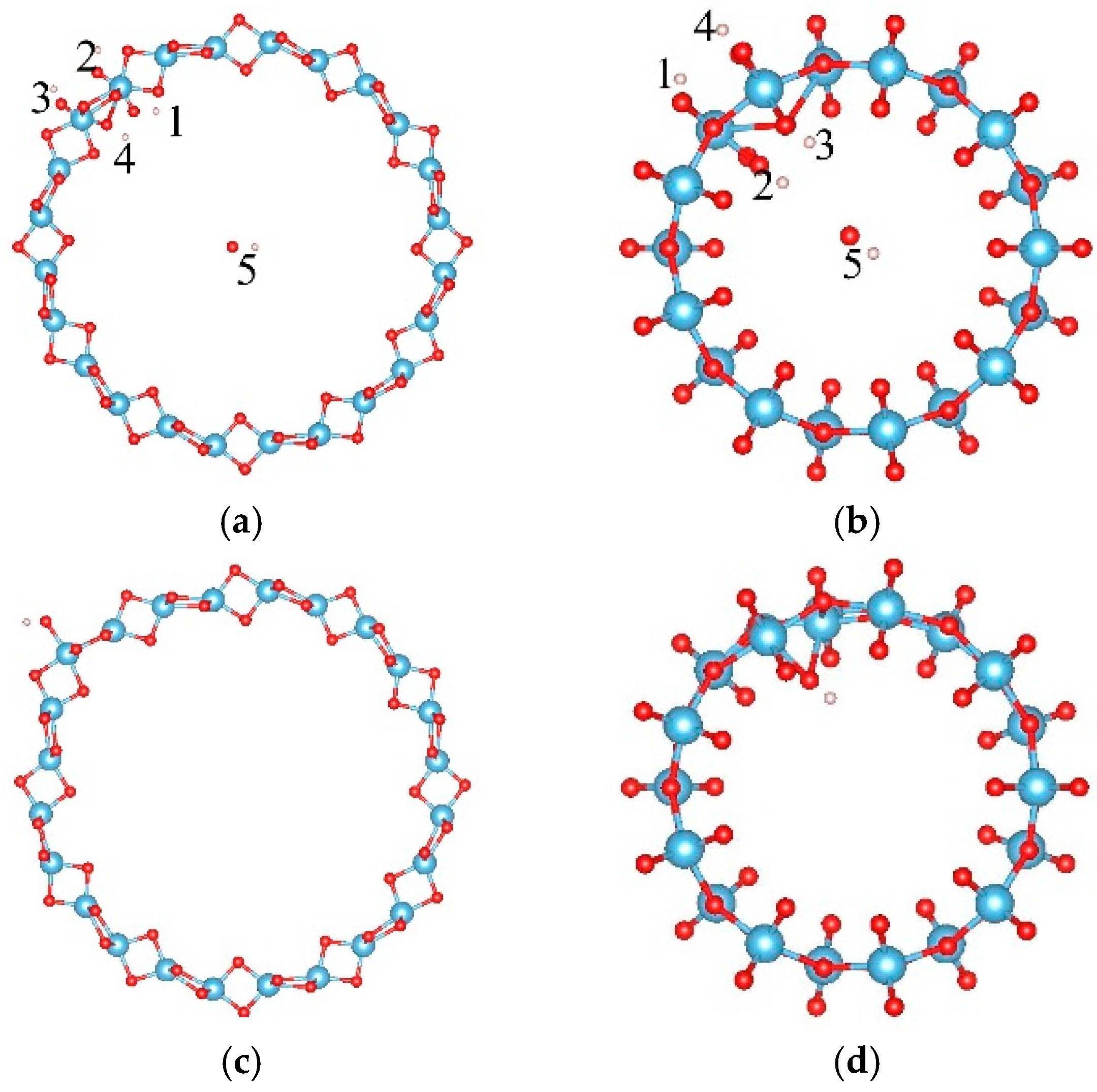
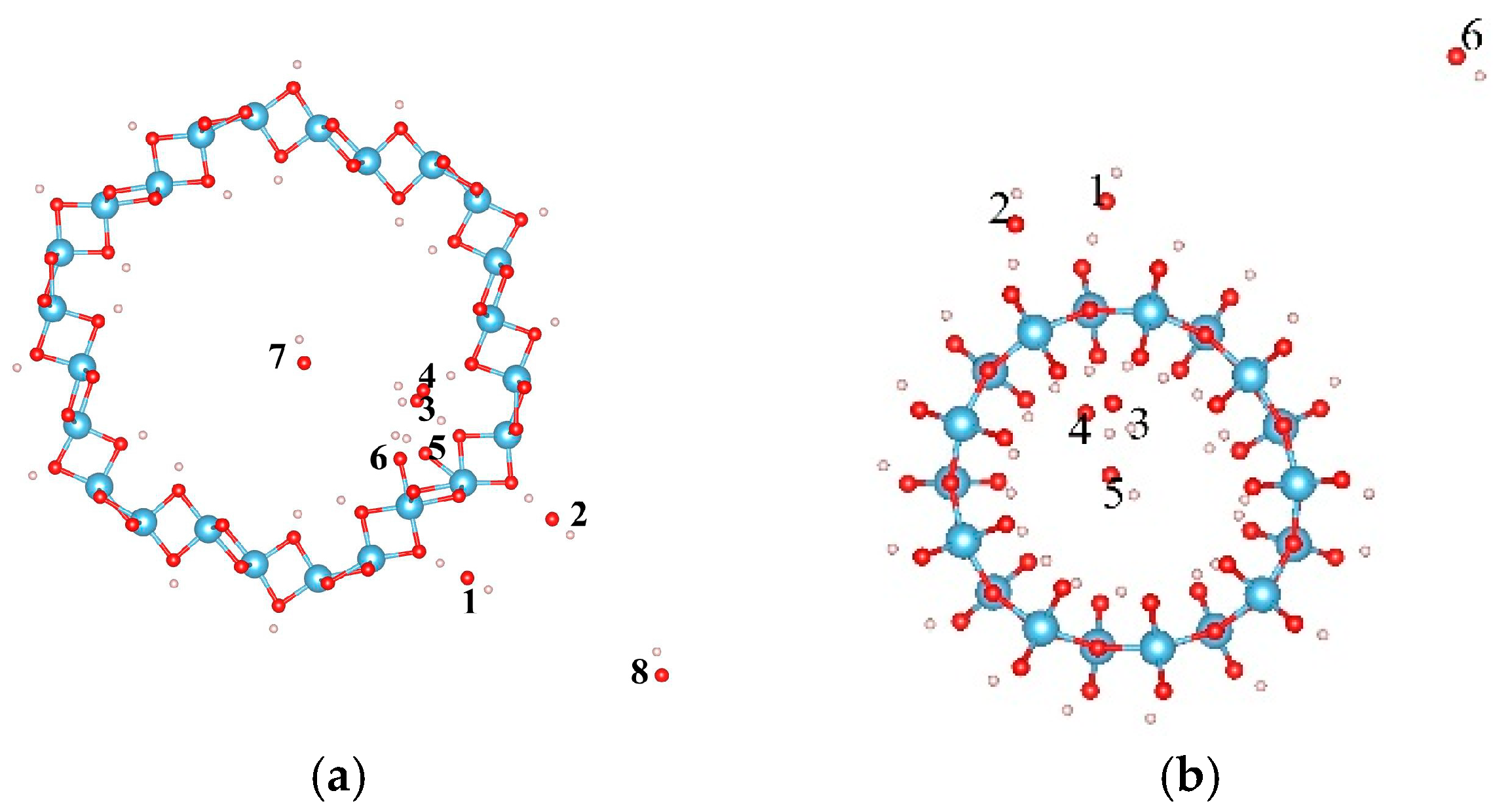
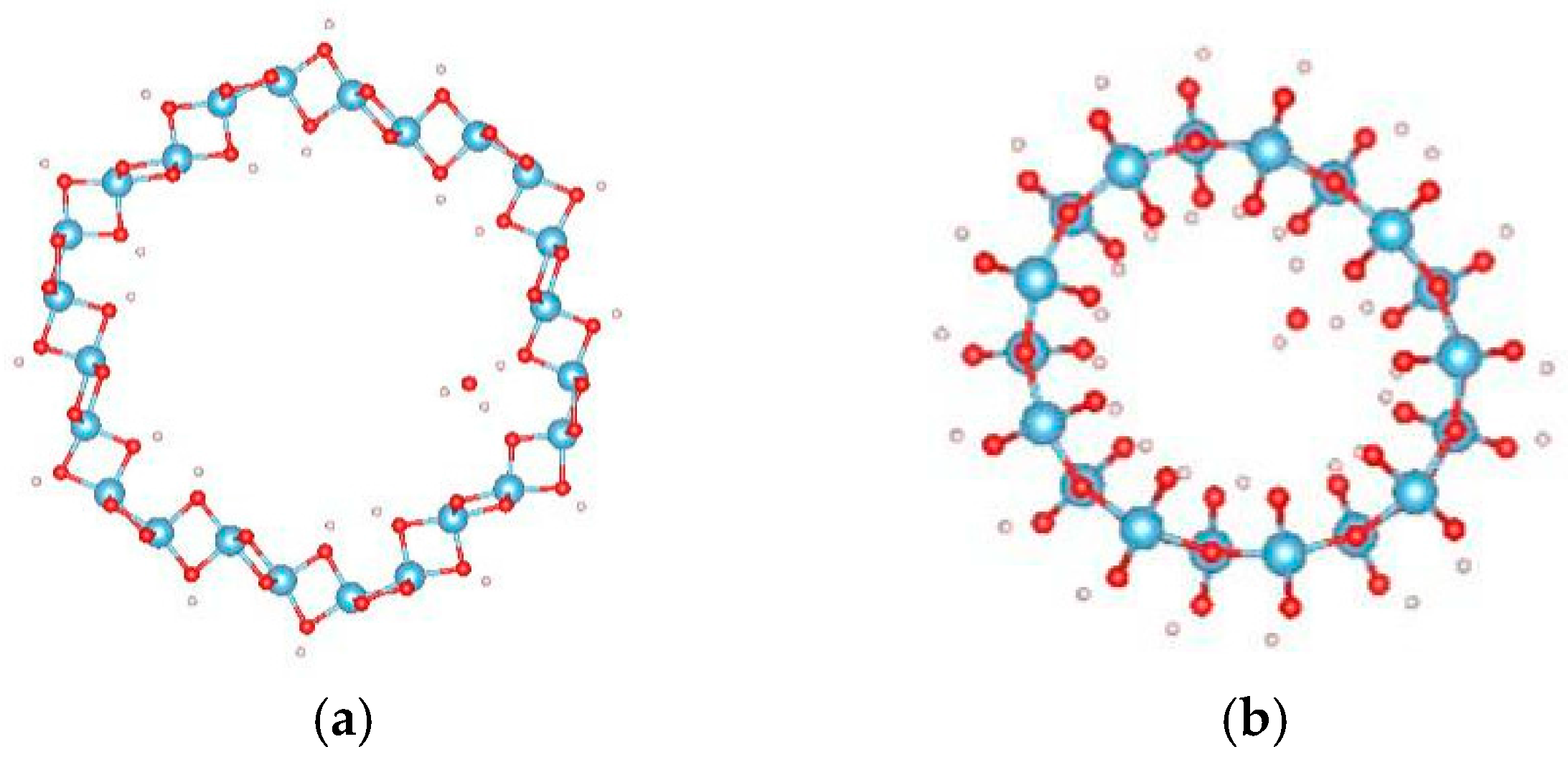


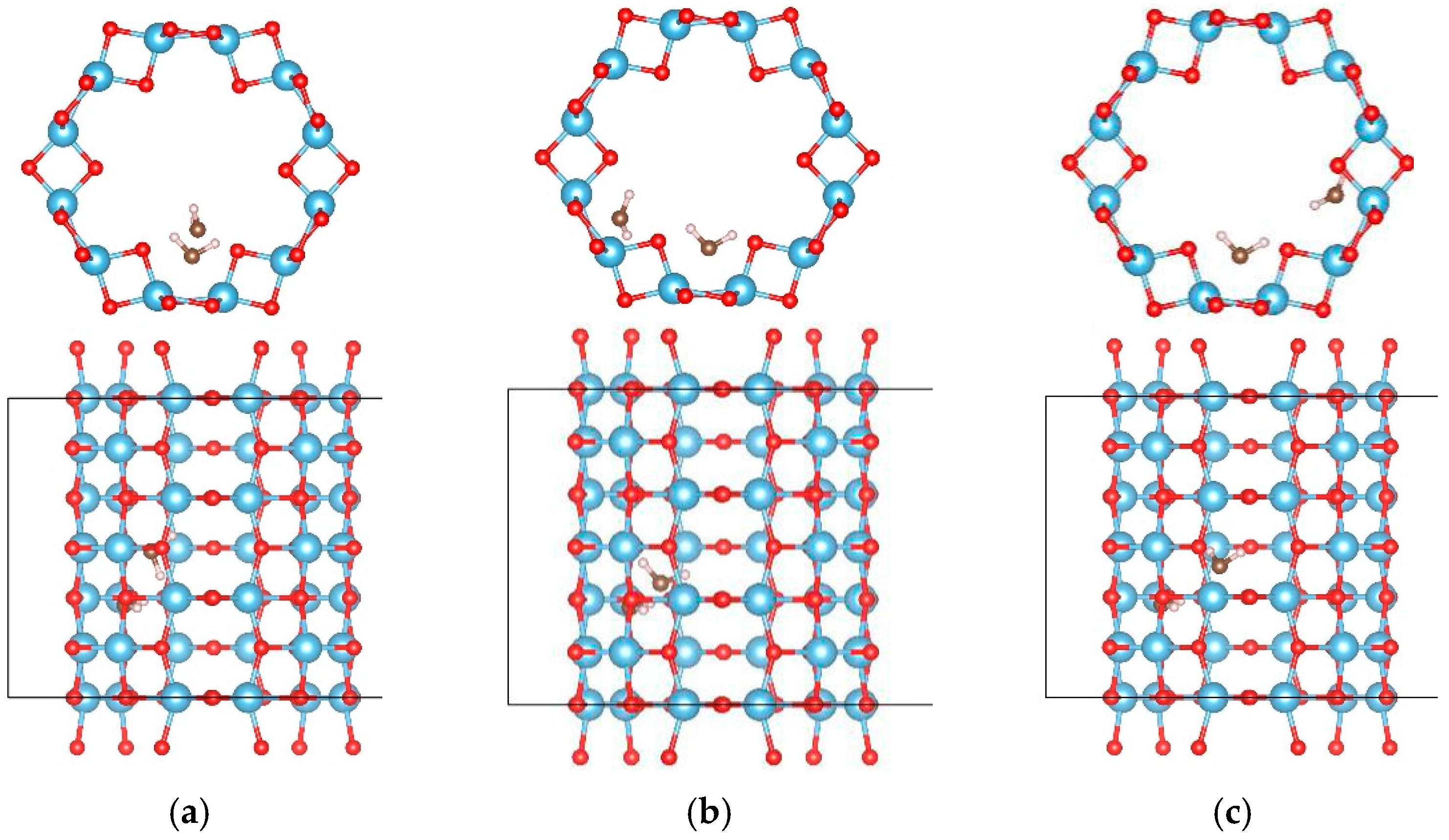
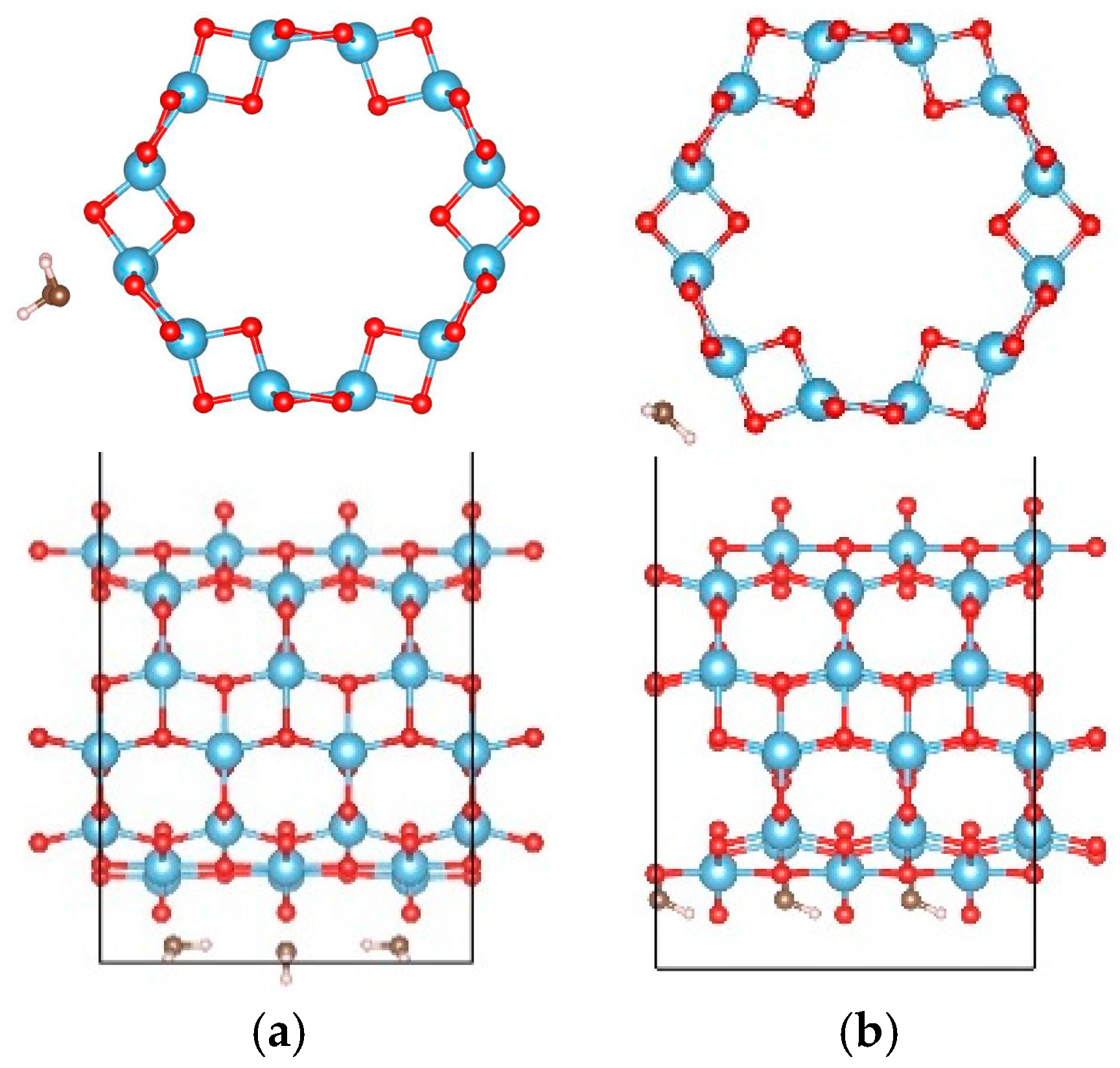
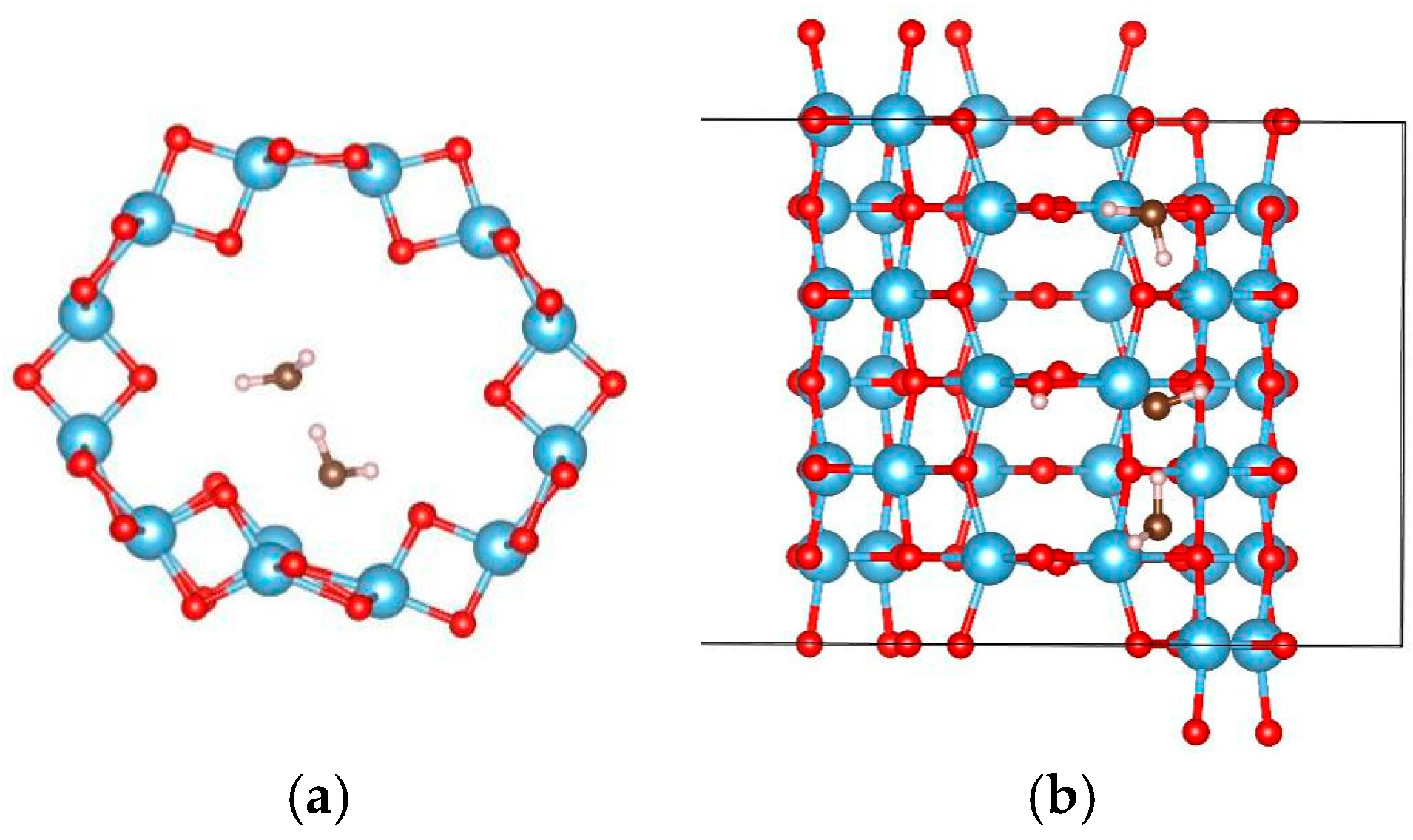



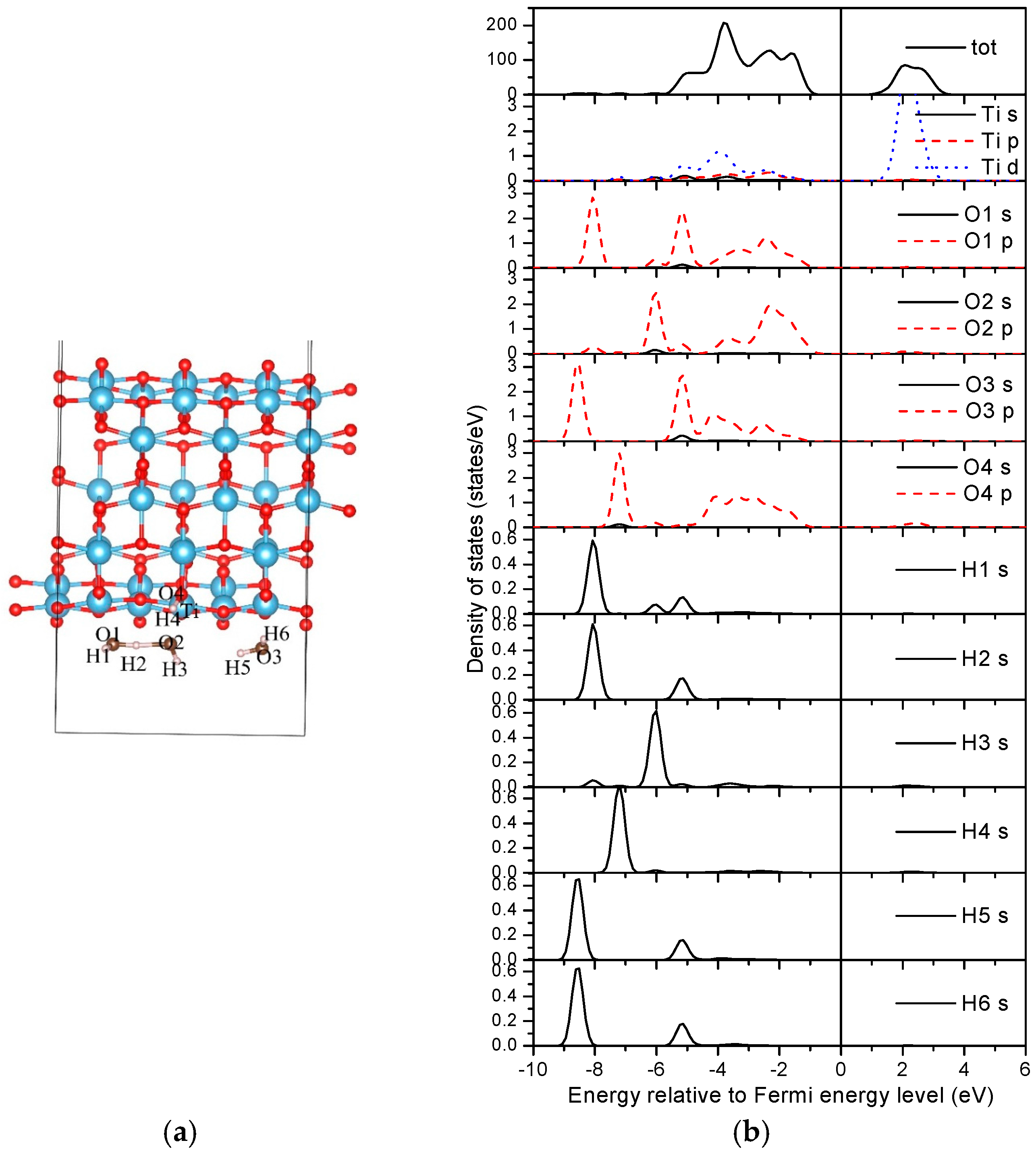
| Adsorption Sites | Eads (eV) on (0, 6) | Eads (eV) on (9, 0) |
|---|---|---|
| 1 | −0.961 | −0.883 |
| 2 | −0.904 | −1.151 |
| 3 | −1.163 | −1.150 |
| 4 | 5.007 | −0.388 |
| 5 | 0.104 | −1.383 |
| Adsorption Site | (0, 6) | (9, 0) |
|---|---|---|
| 1 | −4.490 | −4.885 |
| 2 | −4.390 | −4.943 |
| 3 | −4.796 | −3.917 |
| 4 | −4.627 | −4.332 |
| 5 | −4.720 | −5.013 |
| 6 | −4.207 | −1.343 |
| 7 | −4.096 | – |
| 8 | −0.777 | – |
| Adsorption on (0, 3) | Eads (eV) | Adsorption on 1 × 1 × 3 (0, 3) | Eads | Adsorption on (6, 0) | Eads (eV) |
|---|---|---|---|---|---|
| 1M-1 | −0.660 | 3S-2M-1 | −1.128 | 2M-1 | −1.083 |
| 1M-2 | −0.605 | 3S-2M-2 | −0.887 | 2M-2 | −1.055 |
| 1M-3 | −0.605 | 3S-2M-3 | −0.964 | 2M-3 | −1.054 |
| 1M-4 | −0.414 | 3S-1M-1D | −4.545 | 2M-4 | −1.271 |
| 1M-5 | −0.411 | 3S-3M-1 | −1.294 | 2M-5 | −1.272 |
| 1D | −4.086 | 3S-3M-2 | −1.838 | 2M-6 | −1.272 |
| 3S-2M-1D-1 | −5.430 | 2M-7 | −1.277 | ||
| 3S-2M-1D-2 | −5.296 | 1M | −0.662 | ||
| 3S-2M-1D-3 | −5.264 | 1D | −4.067 | ||
| 1M-1D | −4.693 |
© 2016 by the authors; licensee MDPI, Basel, Switzerland. This article is an open access article distributed under the terms and conditions of the Creative Commons Attribution (CC-BY) license (http://creativecommons.org/licenses/by/4.0/).
Share and Cite
Dai, J.; Song, Y. First Principles Study on the Interaction Mechanisms of Water Molecules on TiO2 Nanotubes. Materials 2016, 9, 1018. https://doi.org/10.3390/ma9121018
Dai J, Song Y. First Principles Study on the Interaction Mechanisms of Water Molecules on TiO2 Nanotubes. Materials. 2016; 9(12):1018. https://doi.org/10.3390/ma9121018
Chicago/Turabian StyleDai, Jianhong, and Yan Song. 2016. "First Principles Study on the Interaction Mechanisms of Water Molecules on TiO2 Nanotubes" Materials 9, no. 12: 1018. https://doi.org/10.3390/ma9121018





